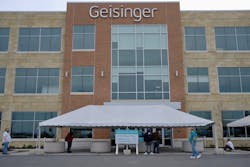At Geisinger, Clinician Leaders Revision Care Delivery to Improve Outcomes
Senior clinician and non-clinician leaders at the Danville, Pennsylvania-based Geisinger Health integrated health system have long been in the vanguard of healthcare delivery innovation, for more than two decades pioneering new strategies and tactics for improved care delivery and outcomes. In that context, over the past five years, Geisinger leaders have decided to reorganize a large number of clinical service lines into consolidated “institutes,” in order to improve both outcomes and efficiency. The results have been excellent, they report, and have accelerated the organization’s forward push into innovation.
Recently, Michael Suk, M.D., J.D., M.P.H., MBA, spoke with Healthcare Innovation Editor-in-Chief Mark Hagland. Dr. Suk is chair of the Geisinger Musculoskeletal Institute, chief physician officer for Geisinger System Services, and a professor of orthopedic surgery at the Geisinger Commonwealth School of Medicine; he continues to practice orthopedic surgery at Geisinger. He spoke with Healthcare Innovation regarding the origin and ongoing evolution of the institute-forming process at Geisinger. Below are excerpts from that interview.
What led you and your colleagues across Geisinger to begin to create the institutes?
We now have seven institutes at Geisinger, replacing what had been 29 separate departments; and I lead the Musculoskeletal Institute. [The other institutes are the Heart Institute, Medicine Institute, Cancer Institute Neuroscience Institute, Surgery Institute, and Women’s and Children’s Institute: see a description here.] The Musculoskeletal Institute was created in 2017, and consolidated under its umbrella several key service lines, including orthopedics, podiatry, physical medicine, and rehabilitation. We’ve done so not just for convenience, but with an eye towards the larger patient experience—understanding that the longitudinal experience around musculoskeletal care connects to how we care for patients before procedures and leading them potentially into surgery or other procedures, and then also tracking them into the post-acute setting, using digital enhancements to help us look at the whole picture. So the Institute helps us look at the totality of care and gives us visibility into how our clinical operations work.
What has the journey been like around this initiative?
Change is always difficult at the beginning, but maintaining the culture of this integrated system made it a bit easier; people understand that everything is connected and is tied together through the EMR. And that realization led to the realization that bringing departments together would support our aims. Of course, questions arise as to who’s in charge of what; but the overall journey has been positive in helping us to make progress and strategize forward.
What types of changes have been made during the overall process?
In our spine care programs, for example, we’ve linked our rehabilitation physicians to the first line for patients with low back pain. We can also connect our physical therapy processes to our overall care for low back pain. And, with regard to our sports medicine clinicians, we can now establish pre-habilitation programs; so if they see a person with advanced arthritis in the sports medicine program, they can be moved into integrated care delivery.
What’s more, we’ve engaged with a number of digital care management tools; one is Force Therapeutics, which keeps us in constant contact with patients, which is highly unusual [Geisinger clinicians and care managers are using the digital care management platform from the New York City-based Force Therapeutics]. We’re now in constant communication through a nurse concierge or digital tools, with those patients, and it allows us to address conditions to enhance the patient experience. We can also avert emergency department visits. Hey, my leg is red and hurts a bit, I’m going to the ED. But instead, we can do a virtual visit, and then see that patient in clinic the next week.
And there are different entities within our organization that are involved, and because we work together in an integrated way. In that regard, Force Therapeutics is a highly curated digital health tool that involves both communication, patient education, tools for patient motivation, and physician feedback, to create a big loop around care. They have a series of highly curated videos to demonstrate how patients should be doing physical therapy; and it’s integrated with Epic, and we also capture patient-reported outcomes, so patients can let us know how they’re doing on a number of different scales.
And more broadly, it represents the larger direction in which we’re going as a musculoskeletal institute, in terms of how to create a better home experience for patients; how to rethink our care delivery so it’s not so hospital-centric.
In other words, you’re thinking of the continuum of care from the highest levels of acuity, all the way across to the home setting, correct?
Yes, that’s right. And our journey around this started long before anyone else was really thinking about this.
Are you interested in creating an explicit hospital-at-home program?
We continue to investigate hospital-at-home programs; it’s a priority. I don’t know whether we’ve launched anything at scale yet, but the concept continues to be an intriguing one. This idea that for all the psychosocial and softer reasons you don’t want to be in the hospital, if we can bring the harder aspects in the home, you’re talking about a different kind of experience for the patient. It can be expensive, and it’s resource-intensive. But we can make it much easier, and perhaps less expensive.
You might be able to avert admissions to SNFs (skilled nursing facilities)?
Our success in reducing acute rehabilitation has been astounding. Using digital post-acute management, dropped acute rehab facility admission by 90 percent. But we still saw patients going to SNFs, because that’s a different population. And I agree that some patients require some level of skilled nursing. But we’re trying to pre-surgically optimize patients better, to avert unnecessary skilled nursing admissions. It’s that longitudinal approach: when a patient doesn’t meet the ideal criteria for an elective procedure, we don’t just say, go lose weight, or stop smoking; we’ll tell you we need you to be within certain parameters for the best outcomes; and now we have an integrated approach to that. Patients who have a higher BMI than we’d like, we have great results with our bariatrics and weight loss department. A good portion of patients end up not needing surgery; if you come in with knee pain and you can lose 60, 70, 80 pounds—many patients no longer experience knee pain and no longer need surgery. We’re closely tied together with our bariatric colleagues, and we share successes across the board.
How does data analytics play into this?
It’s very clear that you can’t do anything without data. We have a ton of data at Geisinger, and we have a lot of tools to help us organize and manage the data. We can see how many surgeries you did, how many infections you had, etc.; we have a high level of granularity in terms of being able to analyze clinical care. The challenge is that data in itself isn’t enough; we have to create larger layers of integration to slice and dice the data in order to create clinical meaning. If we create a dashboard around surgical-site infections within a given year, that would theoretically be important; are we going up or down? But if the swath is too broad, it’s completely unactionable. So we need to go granular and become specific—there could be 50 elements related to surgical-site infections, for example. And to take a for-instance example, let’s say that a patient comes in with a BMI of 36.1; and she’s well-controlled for her hypertension while on hypertensive medication; further, she has strong family relationships. Being able to gather all such variables is very powerful—together, they create the holy grail of data. And, over time, AI [artificial intelligence] could help us to understand such patient profiles in comparison. What’s more, I think the gap between making it clinically integrated and relevant makes it a challenge for us. Those collecting data and creating algorithms, don’t necessarily understand the clinical implications.
You’ve always had the clinicians sitting at the table in those discussions, as you’ve moved forward with your data analytics work, correct?
Yes, that’s part of our DNA; we’re a clinical enterprise.
What have been the biggest lessons learned so far on this journey?
One is that our focus on the consumer/customer experience is the right one. In the face of choosing things, you want to put a high level of focus on in orthopedic or musculoskeletal care, I’ve said, we have to focus on the patient experience. And that’s led us to much larger growth and increased patient satisfaction, and a focus among our clinicians. It’s a step away from seeing a patient as a problem, instead, seeing patients as partners. I see that as a major focus that we took risk on, because it sounds soft, but I think we’ve been very successful towards look at the full picture of care delivery.
What advice might you like to share with informaticists, including clinical informaticists?
It goes back to this notion of clinical integration. Informaticists need to work hard to make sure they speak the language of multiple clinician specialists. So, continue to strive to learn the language of each specialty. And I would encourage more orthopedists and musculoskeletal specialists to become informaticians; I am one. So rather than complaining that nobody understands you, start learning a language that they’ll understand; that’s always been my philosophy.


